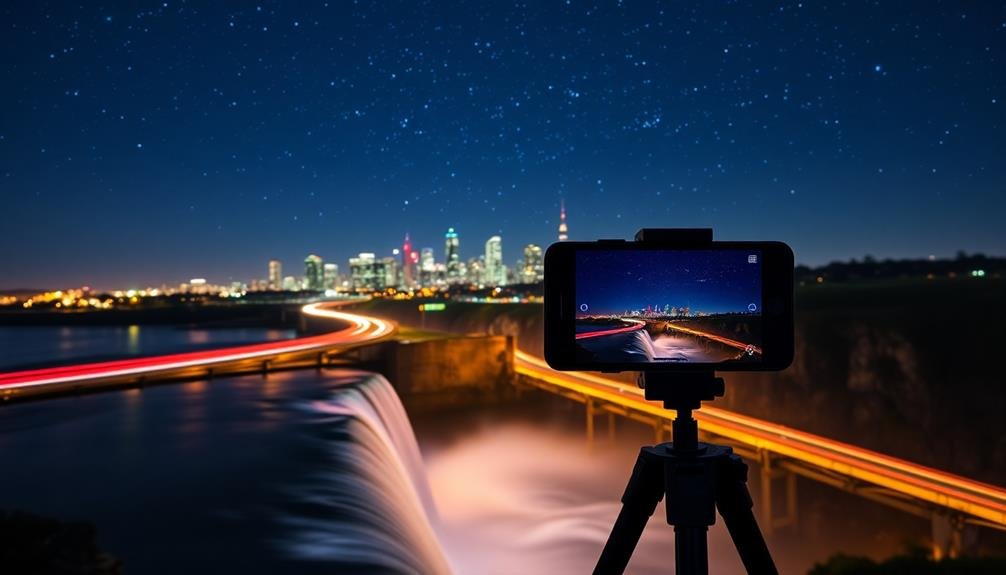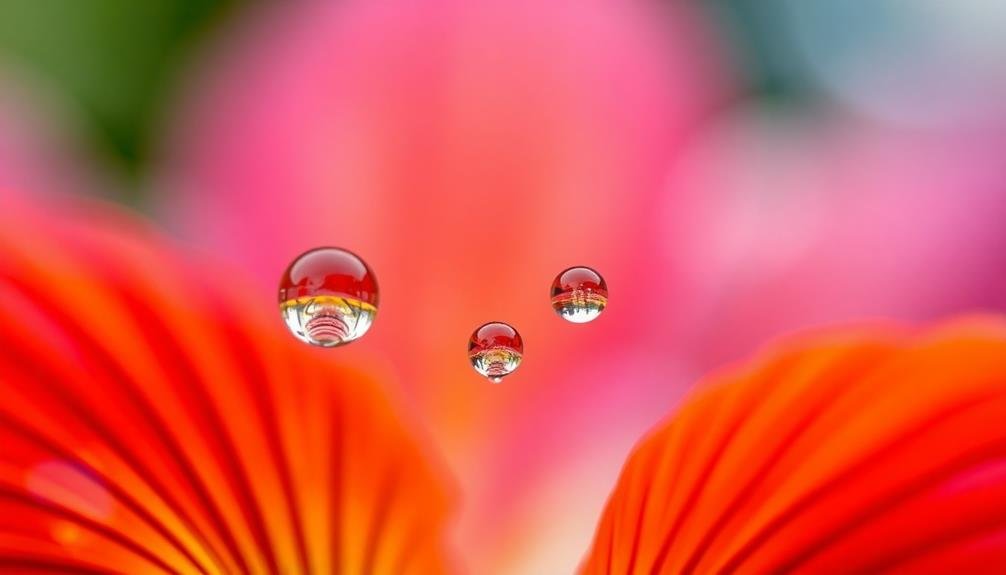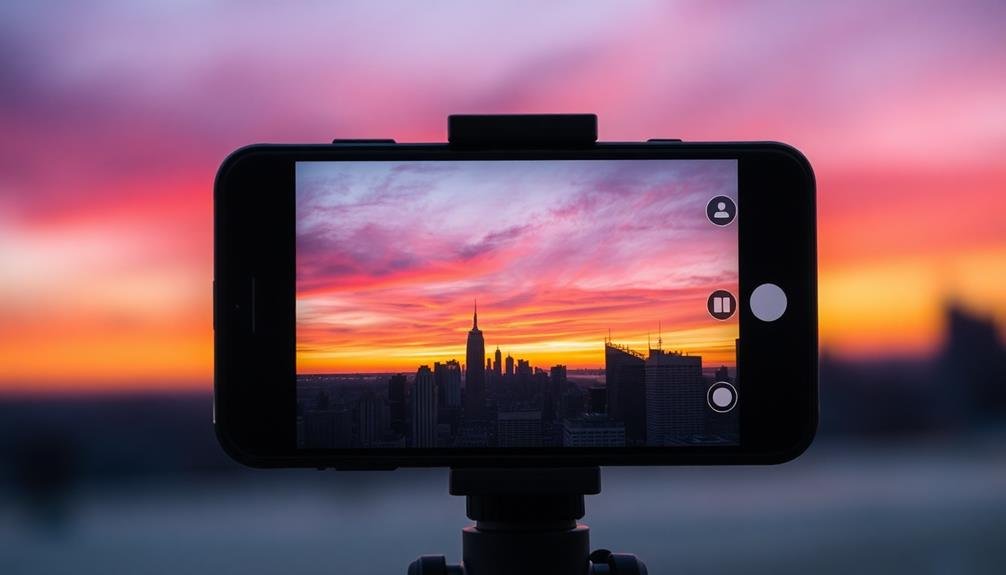To capture stunning long exposure shots on your mobile, start by stabilizing your smartphone. Use a tripod or find a solid surface to eliminate camera shake. Next, adjust your camera settings. Switch to manual mode, lower your ISO, and set a slow shutter speed to capture movement. Finally, choose the right subject. Look for scenes with moving elements like flowing water or traffic lights. Remember to include stationary objects for contrast and interesting compositions. With these three tips, you'll be well on your way to creating mesmerizing long exposure images. Dive deeper to reveal even more secrets of mobile photography mastery.
Stabilize Your Smartphone

To achieve sharp long exposure shots, stabilizing your smartphone is essential. Even the slightest movement can result in blurry images, so you'll need to keep your device as still as possible.
Invest in a sturdy tripod designed for smartphones, ensuring it's compatible with your device's size and weight. Look for models with flexible legs that can wrap around objects, giving you more versatility in positioning.
If you don't have a tripod, improvise with everyday items. Lean your phone against a stable surface like a wall, rock, or fence. Use a small beanbag or a rolled-up jacket to prop up your device at the desired angle. For added stability, use your phone's voice commands or Bluetooth remote to trigger the shutter without touching the screen.
When holding your phone, adopt proper techniques to minimize shake. Tuck your elbows into your body, hold your breath while shooting, and use both hands to grip the device firmly.
If possible, lean against a solid object for extra support. Remember, the longer the exposure time, the more critical stability becomes, so take extra precautions for extended shots.
Adjust Camera Settings

Once you've stabilized your smartphone, it's time to plunge into the camera settings. Most modern smartphones offer manual controls that allow you to adjust exposure time, ISO, and focus.
For long exposure shots, you'll want to set a slow shutter speed, typically between 1 and 30 seconds, depending on your subject and lighting conditions. Lower your ISO to minimize noise, and use a smaller aperture (higher f-number) to increase depth of field.
Many smartphones now include a dedicated "Night" or "Long Exposure" mode, which automatically optimizes settings for low-light conditions. If your device has this feature, experiment with it alongside manual settings to see which produces better results.
Remember to adjust your focus manually, as autofocus may struggle in low light. Tap on the screen to set your focal point, then fine-tune it using the manual focus slider if available.
To create stunning long exposure shots, try these subjects:
- Flowing water turning into silky streams
- Car lights transforming into vibrant light trails
- Star trails painting circular patterns in the night sky
Choose the Right Subject

With your camera settings optimized, selecting the right subject is key to capturing compelling long exposure shots on your mobile device. Focus on scenes with movement that'll create interesting effects when blurred over time. Water sources like rivers, waterfalls, or ocean waves are classic choices, producing silky smooth textures.
Urban environments offer opportunities to capture light trails from passing cars or the hustle and bustle of city life. Look for stationary elements to contrast with the motion blur. A sturdy rock in a flowing stream or a well-lit building amidst traffic can provide an anchor for your composition.
Consider the sky as well; moving clouds can create dramatic streaks across the frame. For a unique twist, try capturing star trails or light painting in low-light conditions.
Don't overlook everyday scenes. A busy street corner, a crowded train station, or even a playground can yield interesting results. Remember, the goal is to show the passage of time in a single frame.
Experiment with different subjects and durations to find what works best for your vision and your mobile device's capabilities.
Frequently Asked Questions
Can I Use Long Exposure Techniques for Astrophotography on My Smartphone?
Yes, you can use long exposure for astrophotography on your smartphone. You'll need a tripod and a specialized app. Experiment with different exposure times and ISO settings to capture stars and celestial objects in your night sky photos.
What Apps Are Best for Long Exposure Photography on Mobile Devices?
You'll want to try apps like Slow Shutter Cam, ProCam, or NightCap for iOS, and Camera FV-5 or Long Exposure Camera 2 for Android. These apps offer manual controls and longer exposure times for stunning mobile photography.
How Do I Prevent Overexposure in Bright Daytime Long Exposure Shots?
You'll want to use a neutral density filter to reduce light entering the lens. Alternatively, try lowering your ISO, using a smaller aperture, or shooting during golden hour when light's less intense. Experiment with these techniques for best results.
Are There Waterproof Cases Suitable for Underwater Long Exposure Mobile Photography?
Yes, you'll find waterproof cases designed for underwater mobile photography. They protect your phone and allow you to use its camera functions. Look for cases with optical glass lenses and depth ratings suitable for your planned underwater activities.
Can I Achieve Light Trail Effects With Long Exposure on Smartphones?
Yes, you can create light trail effects with long exposure on smartphones. You'll need a steady hand or tripod, a slow shutter speed app, and moving light sources. Experiment with car headlights, sparklers, or LED lights for stunning results.
In Summary
You've now got the essential tips for capturing stunning long exposure shots on your smartphone. Remember to stabilize your device, tweak your camera settings, and select subjects that'll shine with extended exposure times. Don't be afraid to experiment and practice – you'll soon master this technique. With these skills in your pocket, you're ready to transform ordinary scenes into extraordinary, dreamy images. So go out there and start creating some mobile photography magic!





Leave a Reply